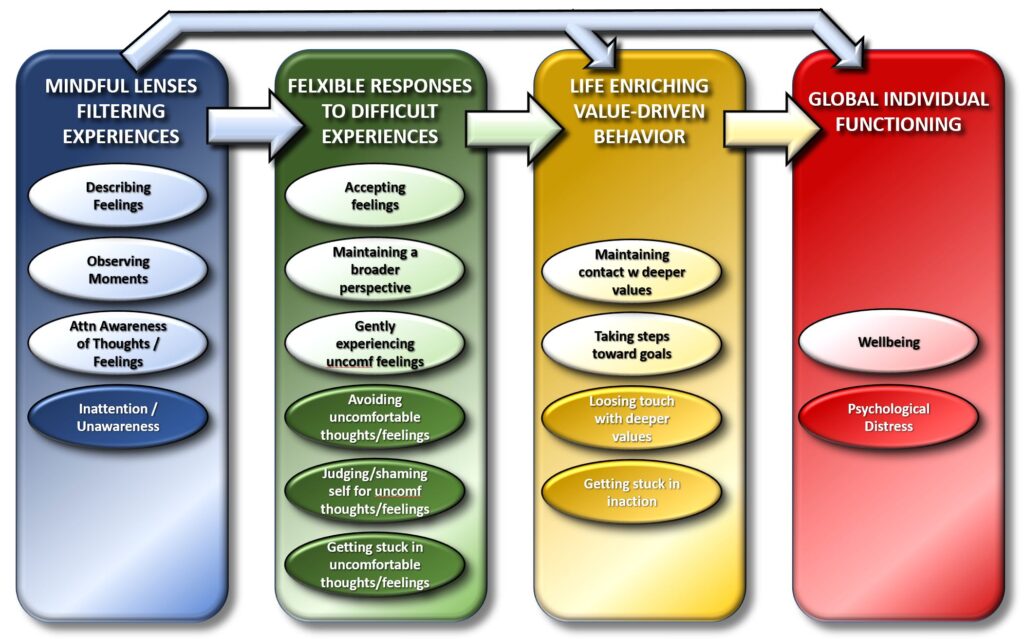Self-Report Scales Developed by the Rogge Lab

In addition to conducting studies focused on understanding and helping couples and families, our lab is also committed to developing high quality (i.e., psychometrically optimized) measures of key constructs.
These scales are freely available for use in both clinical and research settings. No additional permission is necessary for their use.
SPN
The Sex Positivity-Negativity scale (SPN; Hangen & Rogge, 2021) builds on previous work assessing erotophilia and erotophobia by focusing on general positive and negative attitudes toward sex and sexuality.


AAIRS
The Attentive Awareness In Relationship Scale (AAIRS; Daks, Rogge, & Fincham 2021) was developed to assess both relationship awareness and relationship distraction.
UFM
The Unified Flexibility & Mindfulness scale (UFM; Rogge & Daks, 2020) was developed to integrate the dimensions of psychological flexibility from the Hexaflex model of Acceptance and Commitment Therapy (ACT) with the dimensions of mindfulness from the Five Facet Mindfulness Questionnaire (FFMQ; Baer et al., 2006).

The Unified Flexibility & Mindfulness Model
The UFM scale was specifically developed to assess the components of the Unified Flexibility & Mindfulness model. We developed a 70-item version of the scale to provide high levels of precision and power for smaller studies and studies in which these constructs play central roles. We also developed a 28-item version to be used in studies that cannot accommodate the longer version of the scale.

MPFI
The Multidimensional Psychological Flexibility Inventory (MPFI; Rolffs, Rogge, & Wilson, 2016) was developed to assess the 6 dimensions of flexibility and 6 dimensions of inflexibility (comprising the Hexaflex model) that are targeted within Acceptance and Commitment Therapy (ACT).
We developed a 60-item version of the scale to provide high levels of precision and power for smaller studies and studies in which these constructs play central roles. We also developed a 24-item version to be used in studies that cannot accommodate the longer version of the scale.
The MindFlex Assessment Project
We are currently piloting an online service that will generate standardized psychological flexibility profiles for therapists based on the MPFI and the UFM scales. The MindFlex service
- Allows therapists to enroll clients with a brief (2-5min) form
- Sends those clients links to a short (15-20min) online assessment
- Scores and standardizes the responses, generating a profile
- Emails the MindFlex profile to the therapist
These MindFlex profiles will offer therapists objective information that we hope will help them better understand the strengths and challenges that individual clients bring into treatment.
As the therapists can have clients complete follow-up assessments, we hope that the resulting change MindFlex profiles will help therapists track change over the course of treatment.
Right now, the service is being offered completely free of charge as part of a research project to refine that process. In the future, clinicians will be charged small fees for the MindFlex profiles to help cover the cost of maintenance and ongoing development of the service.
MindFlex Assessment Project Website
CSI
The Couples Satisfaction Index (Funk & Rogge, 2007) is a measure of relationship satisfaction. We developed different versions of the scale to accommodate various research settings and needs.
Thus, we developed longer versions for smaller studies in which this might serve as a primary outcome measure - providing the highest precision and power for detecting effects. We also developed shorter versions for massive studies where power is less of an issue and for studies that can only accommodate small numbers of items (e.g., phone surveys, daily diary studies). We would generally recommend using the longest version that your study can reasonably accommodate.
PN-RQ
The Positive Negative Relationship Quality (PN-RQ) scale is a self-report measure developed to separately assess the positive and negative qualities of relationships (Rogge et al., 2016).
The PN-RQ therefore has two main subscales. We developed both a longer 16-item version to provide maximum precision and power in smaller studies and in studies for which this represents a key construct. We also developed a shorter 8-item version (2 separate 4-item subscales) for use in studies where survey length is an issue.
QSI
The Quality of Sex Index (Shaw & Rogge, 2015) is a measure of sexual satisfaction and dissatisfaction. We developed different versions of the scale to accommodate various research settings and needs.
The scale has two main subscales as our analyses suggested that sexual satisfaction was reasonably distinct from sexual dissatisfaction. Thus, we would recommend using both subscales whenever possible to capture both aspects of sexual quality.
We validated separate 6-item and 12-item versions of each subscale, once again trying to accommodate a wide range of research settings. When possible, we would recommend using the longer versions of the subscales as they will provide greater precision and power in analyses.
MoSBI
The Meaning of Sexual Behavior Inventory (MoSBI) is a self-report scale that assesses an array of both positive and negative meanings of sexual activity in romantic relationships (Shaw & Rogge, 2016).
Analyses suggested that, consistent with symbolic interaction theory, the various positive and negative meanings of sexual activity moderated the impact of sexual activity on romantic relationships over time.
Positive meaning subscales
- to share pleasure
- to bond
- to de-stress
- to energize the relationship
- to learn more about each other
Negative meaning subscales
- to manage conflict
- as an incentive
- to express anger
- to control a partner
ARS & DQS
The Attentive Responding Scale (ARS) and the Directed Question Scale (DQS) are self-report measures developed across a series of studies (Maniaci & Rogge 2014) to identify respondents giving excessively poor attention and effort on surveys.
Analyses suggested that both of these scales identify roughly 3-5% of respondents that were excessively inattentive when completing online surveys. Removing those participants from analyses yielded increases in power.
The ARS has two subscales (inconsistency and infrequency) with two different total lengths (18 or 33 items). We would recommend using both subscales as that serves as a more effective screen. However, researchers can choose to use just a single subscale of the ARS (e.g., the infrequency subscale) or the DQS if survey length is an issue.
Aversive Interaction Scale - AIS
The AIS is a self-report measure designed to assess hostile conflict behavior, aggression, and deception within romantic relationships (Rodrigues & Rogge, 2007). Although the research article validating it was never published in a peer-reviewed journal, the AIS hostile conflict subscale has been used in over a dozen of Dr. Rogge's published research articles and has functioned extremely well across all of those studies. The items of the AIS can be found at the end of the unpublished manuscript.